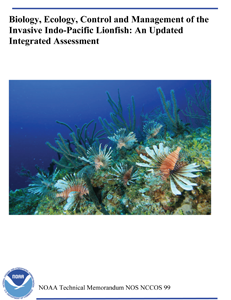Venomous Indo-Pacific lionfish (Pterois miles and P. volitans) are now established along the Southeast U.S.A. and parts of the Caribbean and pose a serious threat to reef fish communities of these regions. Lionfish are likely to invade the Gulf of Mexico and potentially South America in the near future. Introductions of lionfish were noted since the 1980s along south Florida and by 2000 lionfish were established off the coast of North Carolina. Lionfish are now one of the more numerous predatory reef fishes at some locations off the Southeast U.S.A. and Caribbean. Lionfish are largely piscivores that feed occasionally on economically important reef fishes. The trophic impacts of lionfish could alter the structure of native reef fish communities and potentially hamper stock rebuilding efforts of the Snapper –Grouper Complex. Additional effects of the lionfish invasion are far-reaching and could increase coral reef ecosystem stress, threaten human health, and ultimately impact the marine aquarium industry. Control strategies for lionfish are needed to mitigate impacts, especially in protected areas. This integrated assessment provides a general overview of the biology and ecology of lionfish including genetics, taxonomy, reproductive biology, early life history and dispersal, venom defense and predation, and feeding ecology. In addition, alternative management actions for mitigating the negative impacts of lionfish, approaches for reducing the risk of future invasions, and directions for future research are provided.

